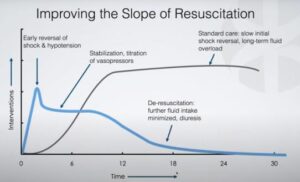
Interpreting research and applying it to clinical practice isn’t easy–especially in EMS and emergency care, where clinical trials can be difficult to execute, and the evidence sometimes derives from other areas of medicine. That’s certainly the case in the discussion about fluid resuscitation in sepsis patients.
A few studies in recent years convinced some clinicians that fluid resuscitation in sepsis – even in hypotensive patients – is unhelpful at best or even likely to be dangerous. But the truth is, when you look at the research, these studies weren’t looking at the dry septic shock patients we see in the earliest minutes of care. Most patients in these studies had already received several liters of fluid prior to starting the protocol. They were hours into the resuscitation, sometimes already in the ICU. Often very different from what we see at presentation.
The research that does look at the earliest moments of sepsis patient resuscitation, prehospital and early ED presentation, shows that early fluid administration in patients with hypotension makes a positive impact. It improves outcomes and reduces the need for heroic interventions like mechanical ventilation. Unfortunately, this information isn’t widely known or understood, and not enough patients are receiving this early resuscitation.
In this recent presentation to a group of EMS physicians, Mark Piehl, MD, breaks down the research and misunderstandings and discusses what it really means for prehospital clinicians. He reviews both the CLOVERS trial and the CLASSIC trial, two studies that looked at the difference between restrictive and liberal fluid resuscitation and details the methods and data and explores why the studies don’t tell us much at all about prehospital or early hospital care for hypotensive sepsis patients.
He also digs into the studies that are designed to evaluate the early moments of sepsis care (summarized below). Quick takeaway: early fluid boluses in patients with sepsis and hypotension improve outcomes.
- Seymour et al showed that prehospital administration of fluids to hypotensive sepsis patients reduced mortality by more than half–from 30% to less than 15%.
- Lane et al found that when EMS initiated fluid boluses in sepsis patients who were hypotensive (SBP<100), mortality decreased.
- Kuttab et al reported that a failure to give 30 mL/kg of crystalloid fluid in the first 3 hours of treatment resulted in longer ICU stays and increased mortality.
- In a meta-analysis of studies examining prehospital and initial ED care for hypotensive sepsis patients, Ward et al found the odds of mortality were half for patients who got fluid early.
Watch the presentation and learn why it’s important to look past the headlines and see exactly what each study was studying–who the patients were, what the timing of the resuscitation was, and what outcomes were being examined.

